Linen flower brooch with wooden beads
Luck and tree are perfectly combined. Two tiers of seven petals with a lush central part. As usual, on a wire frame. Unusually: petals are associated diagonally. In diameter, about 9.5 cm. Sits perfectly even on fine tissue.
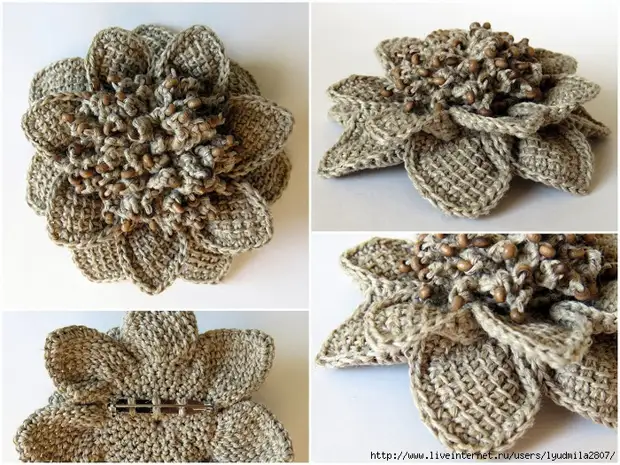
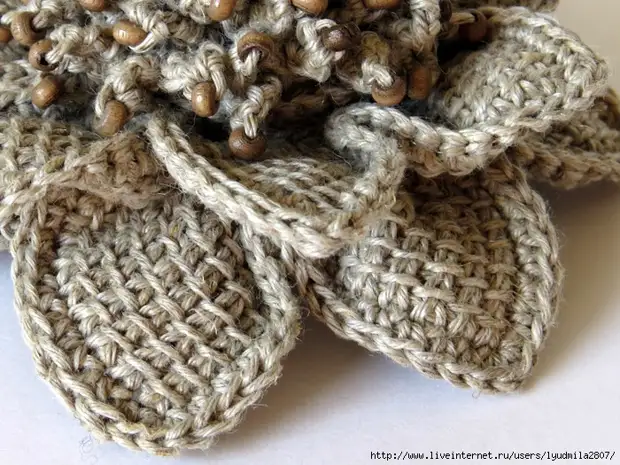
All the same Tunisian knitting, as before, but "diagonally". Such an effect is obtained if, when taking the petals to start with one column, in each next row to make an increase and, reaching the desired height, close the loop to the base.
Hook number 1.3 (maximum of those that usually use, since the thread is thick). Minimum number 0.5: for Moulin and thin coil threads. I use Tulip and Gamma hooks. There are several Dolphin hooks, but they did not go.
January 21, 2014 Another fantasy flower
Another test of the diagonal Tunisian knitting. Two tiers of five petals. Threads Madeira Decora No. 6 with short sections of the shades of brown, khaki, beige and dust-pink (they were purchased in December 2011 :)). Glass beads with imitation under the "cat's eye". Wire frame. 8.5 cm in diameter, the middle part is about 5 cm.
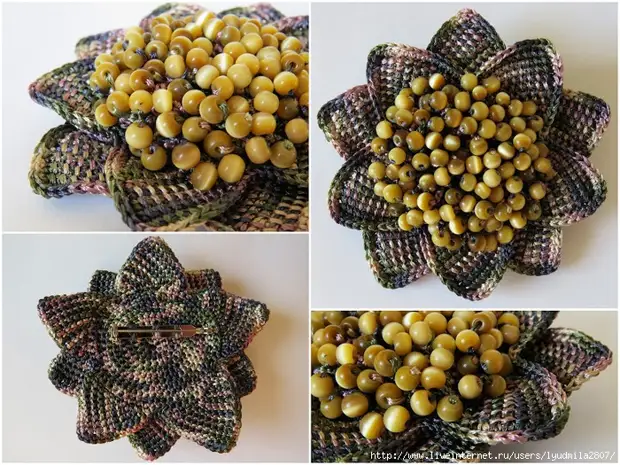
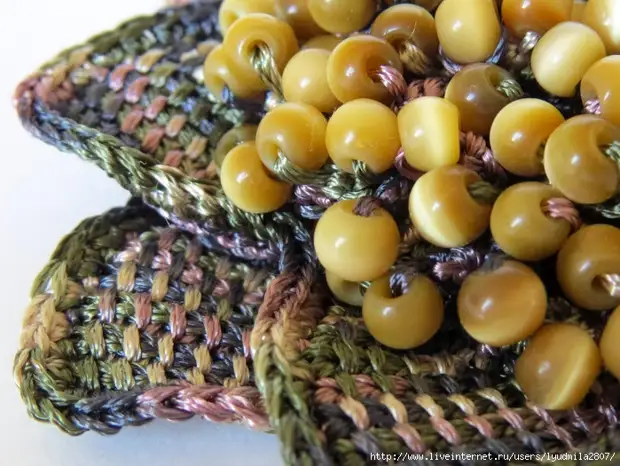
When knitting a rectangular Tunisian web in the reverse row, the first loop is always given by a single (edge loop), and the rest of two. When you encounter Tunisian web perpendicular to the edge of the already associated (as in the case of flowers), then all the loops need to be twisted in two ( Since the last loop in the set row is pulled out from under the loop of the base base). And if the first is still to prick a single, then the effect of increasing the number of loops in a row without special increases will be observed.
Striped flower brooch
Another brooch. As usual, Tunisian bits, Yarnart Tulip yarn, glass beads in the center and wire frame around the perimeter. From the new: I tried to knit from two different motors with a color shift (blue + blue). In the future, you can achieve a spectacular color scheme (rainbow, for example, having), but the process itself is quite a vigorous.
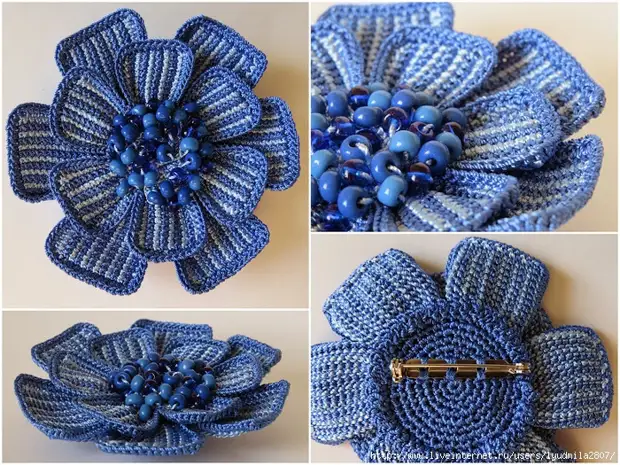
Question in the comments. What ratio Thread Thickness: Bead / Beads Do you use? I tried to knit, but I can't get a flat circle, it turns inside and that's it, especially when I make beaded loops.
Answer. And it is twisted. If the twist is not very strong and the convex middle even wins, then you can inside to maintain a form filler for toys. Well, if you really want a flat middle, you will have to be sick: each second (or third, or fourth, or fifth, or ...) loop to lies without beerin. With beaded loops, you can skip entire rows: one row - with hinges, the other - without. But in this striped flower and large beads used at all, which could not be put in a flat circle (and did not want). I knitted a round part of the columns without a nakid for the rear half. On the front side, a spiral line was obtained formed by the front semi-bypass. On these front half-semifies, the arches of air loops, placing beads in advance to the center. Tie easier than to describe.
Orange Mak.
Of course, 6 petals in poppy - it is wrong, but he is knitted, he can. All the same threads Yarnart Tulip, Tunisian knitting in petals and wire around the perimeter.
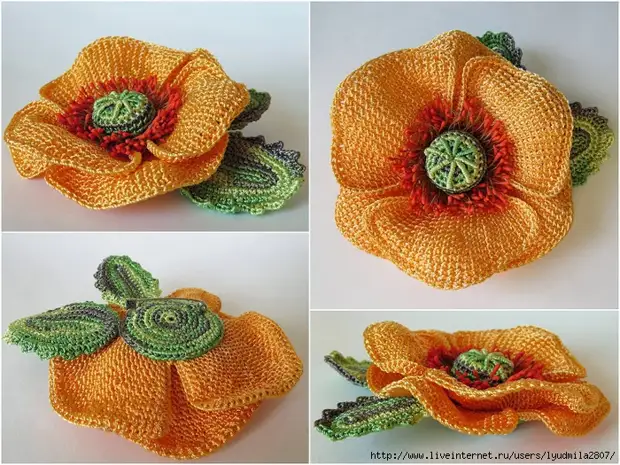
The stamens are made by hand from threads and tinted Path (there are a lot of different MK on the network). A little troublesome, but pleases the result: light, thick, pleasant to the touch.
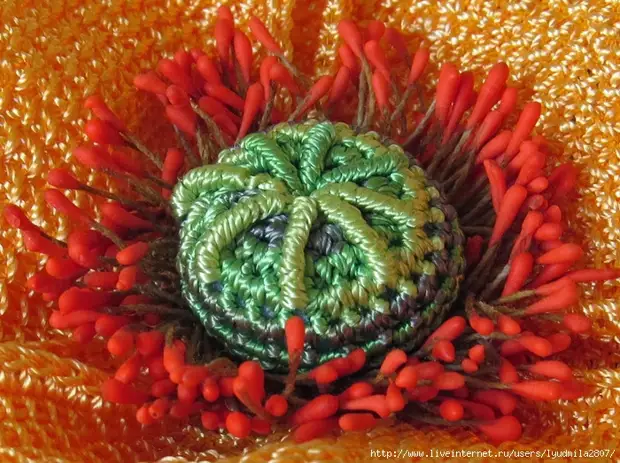
Threads for stamens impregnated PVA. I will not say that it turned out very rigid. I would like stronger fixation. In some MK for impregnation, gelatin is used. I'll try somehow. Pat is a sour creamy mixture of PVA and starch (in some master classes instead of starch used flour). In Pat, the tips of the threads of the stamens are obtained, such balls are obtained. After drying, they can be painted. And you can immediately make a color, adding paint to it (I did it). I had an acrylic for the fabric of the company "Gamma". The mixture of yellow and red behaved well: it turned out, as I wanted, orange. After drying, the color has not changed. But I tried to wash the purple color for the corn ... everything was fine in the "wet", but after drying, they became dirty-black.
Cornflower
Tied about a month ago. At first, the hands did not take a picture, then there was no time to copy the pictures onto the computer, then the collage of the photos was lazy. Everything is as always: a combination of ordinary and Tunisian knitting, a wire frame around the perimeter of parts, a hook 0.9, threads Yarnart Tulip. Stamens - from impregnated PVA threads with Path balls at the ends. I like it: a pretty, small and relatively quickly knits (with stamens, however, you need to tinker). Perhaps I will try to make a step-by-step description.
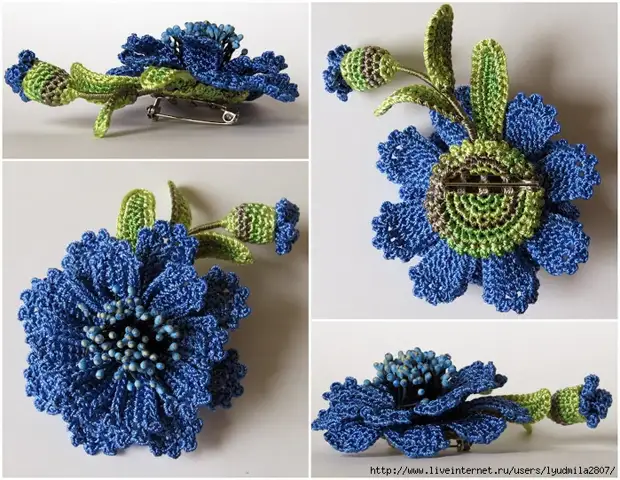
Pate stamens look natural than beads. But they will do longer. But you can immediately prepare. I spied about the stamens in the silk floristry, it is a classic genre in fabric colors. In the manufacture of colors from the fabric, such stamens are completely used nearby. The process is not fast, but if in a nutshell, then the threads must be impregnated with PVA and dry them in a stretched state. The impregnated and dried threads should be cut into segments of two times more than the desired stamens. Each segment bend in half: it turns out such a "tick". The tips of each "check mark" are loose in pat and, like linen, hang drying. Pat is a mixture of PVA and starch, tinted with paints. Pat freezes on the tips of the thread with droplets, which, after drying, can be additionally toned if desired. I here this MK seemed very sensible
